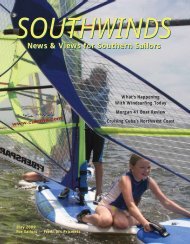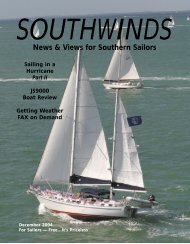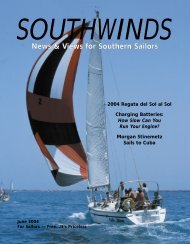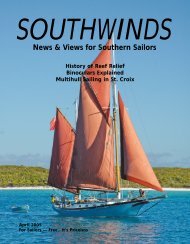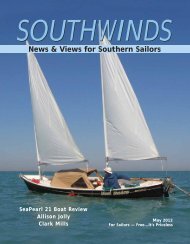Read PDF - Southwinds Magazine
Read PDF - Southwinds Magazine
Read PDF - Southwinds Magazine
You also want an ePaper? Increase the reach of your titles
YUMPU automatically turns print PDFs into web optimized ePapers that Google loves.
Around Memorial Day, numerous reports of dead fish began to<br />
come in. Thousands of fish were suddenly belly up in the water.<br />
The health departments of three counties bordering the St. Johns<br />
issued statements advising people to stay out of the water where<br />
there were algae blooms or dead fish. Photo by Walter Koker.<br />
Protection began studying the phenomena. While there’s no<br />
definitive answer, it seems to be related to the algae. Algae<br />
blooms are directly linked to excess nutrients in the water.<br />
Armingeon states, “Nutrient pollution was and still is one of<br />
the most significant threats to the river’s health.” One of the<br />
worst known offenders is nitrogen from fertilizers we use to<br />
make our yards, golf courses and football fields look lush<br />
and green. When it rains, excess fertilizer runs off into storm<br />
drains and into the river.<br />
Who’s really to blame Armingeon doesn’t mince<br />
words. “The biggest polluter is all of us in our daily activities.<br />
We put more nitrogen and phosphorus into the St. Johns<br />
River than it can assimilate. Meaning more than it can dilute<br />
to a safe level. The river can’t take any more in and remain<br />
healthy.”<br />
There are a few things an individual can do to help.<br />
According to the Riverkeeper pamphlet “Do Not Feed the<br />
Algae” you can…<br />
This year, there was the addition of a mysterious white foam,<br />
which appeared seemingly everywhere. It’s not the sea foam you<br />
might see on the beach or somebody’s washing machine overflow.<br />
It is heavy viscous foam that floats along in huge rafts and collects<br />
to completely cover some backwater areas. Photo by Dana<br />
Morton.<br />
is what is it we value What do we want to leave our kids<br />
The oil spill will make people realize the future of Florida,<br />
the thing we have that nobody else has, is our natural<br />
resources. We all caught a glimpse of what polluted water<br />
means to our state — it’s our death. We all have to rethink<br />
how we live.”<br />
• Use slow-release low-phosphorus fertilizers.<br />
• Use organic fertilizers, if possible.<br />
• Avoid applying fertilizer before a heavy rain.<br />
• Plant low-maintenance plants next to driveways<br />
and waterways to prevent runoff.<br />
• Water your lawn only when necessary — twice a week<br />
is ideal.<br />
• If you have a septic tank, make sure it’s operating<br />
properly.<br />
If you are a sailor or boater and wish to be part of the<br />
Riverkeeper’s river patrol — to report sightings of pollution,<br />
illegal dumping or fish kill events, or, if you want to<br />
learn more about the Riverkeeper organization, you may go<br />
to www.stjohnsriverkeeper.org.<br />
Armingeon and the other Riverkeeper organizations in<br />
Florida, and around the world, continue to fight for clean<br />
water and educate the public. They realize it’s a battle that<br />
may last generations, but successes like the Hudson River in<br />
New York show some battles can be won.<br />
To drive home the scope of the problem, Armingeon<br />
quotes, “In 2008 DEP estimated that 1000 miles of Florida<br />
rivers and streams, 350,000 acres of lakes and 900 square<br />
miles of estuaries are contaminated by sewage, fertilizer or<br />
animal manure. They don’t meet their quality standard of<br />
being fishable and swimmable.”<br />
Then, he pointedly adds, “The question we have to ask<br />
31% of boats aren’t insured.<br />
I can help you make sure you don’t get stuck with 100% of the<br />
cost if something happens. For less than $1 a day*, Allstate Boatowners<br />
Insurance can cover things like injury, theft, and damage<br />
to your boat, or someone else’s. Don’t wait. Call me today.<br />
PAUL HESS PHANEUF<br />
(813) 353 0303<br />
3641 W KENNEDY #E, TAMPA<br />
a076075@allstate.com<br />
*Based on 2009 countrywide average gross premium for boatowners insurance. Your actual premium will<br />
vary based on state and value of boat. Subject to availability and qualifications. Allstate Property and Casualty<br />
Insurance Company, Northbrook, IL. © 2009 Allstate Insurance Company<br />
News & Views for Southern Sailors SOUTHWINDS September 2010 33



